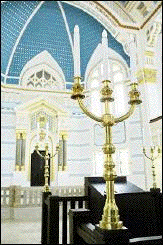|
.
|
Eastern
Europe's first Holocaust museum set to open in Budapest
BUDAPEST
: The first Holocaust museum in Central Europe will open
Thursday [April 15, 2004] in Budapest on the 60th
anniversary of the day Hungary's pro-Nazi regime started
rounding up Jews to confine them in ghettos.
An estimated 600,000 Hungarians perished in the
Holocaust, most of them Jews.
More than 437,000 Jews were deported to Nazi death camps
in less than two months in 1944.
"More than a museum, this must be a place for learning,
especially for the young who must not only know of the
Holocaust but make it part of their lives so that they
will never allow it to happen again," museum director
Andras Daranyi said.

|
..
|
|
A
view of the museum.
|
|
.
|
Hungarian Prime Minister Peter Medgyessy, Israeli
President Moshe Katzev and French Finance Minister
Nicolas Sarkozy, who is of Hungarian descent, are
expected to be among the dignitaries attending the
inauguration.
Located on a narrow street in Budapest, the memorial
center is built on the site of a pre-war synagogue which
had served as an internment camp for Jews during World
II.
The museum is the fifth state-funded Holocaust museum in
the world according to its organizors, after ones in
Jerusalem, Washington D.C., London and Berlin.
It will open with a temporary exhibition showing
photographs of Hungarian victims arriving to Auschwitz
from the northeastern village of Bilke, which is now part
of Ukraine.
In the courtyard, the names of those who perished in the
Holocaust are put on a memorial wall. Some 40,000 names
are known and new ones are added as research discovers
the identities of the victims.
The museum has, however, been criticized in Hungary,
which has eastern Europe's largest Jewish population,
estimated at 60,000-100,000.
Historians have said the museum should have been built in
the countryside, where most of the Jews lived in pre-war
times, or in the former area of the ghetto in the
capital.
The current location in a nondescript neighbourhood with
narrow streets not only lacks historical significance but
is also difficult for cars and tourist buses to reach,
critics charge.
But the most stinging criticism is that there will not be
a permanent exhibition documenting the Holocaust in place
at the opening and, some argue, there is not even enough
space for it on site.
"It's a slap in the face to the Holocaust and its
victims," Laszlo Karsai, one of the museum's curators,
told Nepszabadsag newspaper last month in protest of the
limited space.
The museum's directors argue, however, that opening the
museum even without a permanent exhibition was a moral
obligation to educate Hungarians, for whom the
participation of Hungary's collaborationist government in
the deportations remains a sore topic.
"We want to be a springboard for debate in society about
the Holocaust," Daranyi said.
The emphasis on education also resonates in Hungary,
where the so-called "numerus clausus" law of 1920
restricting the admission of Jews to universities was the
first anti-Jewish law passed in Europe ahead of the
war.
"How did this degenerate into deportations and murder 20
to 25 years after the first anti-Jewish law was enacted?
And how come so few raised their voices against this?"
asked Daranyi.
"We don't want to give answers, we want to pose
questions," Daranyi said.
Copyright © 2004 Agence France
Presse. All rights reserved
.
|
.
|